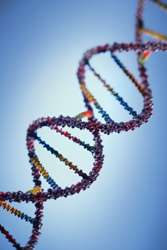Quantifying protein-folding mechanisms

European scientists are investigating the mechanisms by which proteins fold to form complex configurations using single-molecule experimental techniques.
Proteins are complex three-dimensional (3D) structures formed by chains of amino acids (their primary structure). The chains fold and line up to form sheets or helices (secondary structure) and in more complicated ways to form innumerable geometrical configurations directly related to their eventual functions (tertiary and quaternary structures).
The method by which a protein arrives at its final configuration is thought to be governed by its so-called free-energy landscape. Energy landscape theory states that the primary sequence of a protein defines its free-energy landscape which determines its folding pathway and the rates of folding and unfolding.
The path to a protein's final equilibrium state (as well as the properties of the final state itself) is guided by hills and valleys in the energy landscape.
Spectrin is the main component of a protein network that lines the inside surface of red blood cells (erythrocytes) and is thought to be responsible for maintaining their shape (it is cytoskeletal in nature).
It forms a three-helix bundle where the three different domains (R15, R16 and R17) fold to their native conformations at speeds that vary tremendously, despite their apparently identical structures and properties. Evidence points to diversity in energy landscape 'roughness' as an explanation for the different folding rates – slow-folding domains (R16 and R17) have rough landscapes whereas fast-folding R15 has a smooth one.
Present knowledge of energy landscape roughness comes primarily from theory and computer models. European researchers sought to directly investigate the energy landscape of these three spectrin domains.
With funding of the Spectrinroughness project, scientists are employing state-of-the-art single-molecule spectroscopic methods (single-molecule Förster resonance energy transfer, smFRET, and fluorescence correlation spectroscopy, FCS) together with novel mathematical analyses to experimentally quantify energy landscape roughness.
The Spectrinroughness project has already yielded the first measurement on an unfolded native state of certain parameters related to folding. Continued research will no doubt provide novel experimental data and descriptions of energy landscape roughness as well as tools related to and applications of single-molecule biophysics techniques.
Provided by CORDIS


















